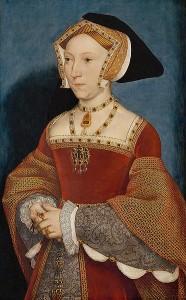 This “on this day in history” event always makes me see red! Yes, just eleven days after his second wife, Queen Anne Boleyn, was executed at the Tower of London on trumped up charges – I think most people would agree with me on that – King Henry VIII married for the third time.
This “on this day in history” event always makes me see red! Yes, just eleven days after his second wife, Queen Anne Boleyn, was executed at the Tower of London on trumped up charges – I think most people would agree with me on that – King Henry VIII married for the third time.
The marriage took place at Whitehall Palace, formerly known as York Place, the very property that Henry had renovated with Anne Boleyn. The bride was Jane Seymour, daughter of Sir John Seymour of Wulfhall, in Wiltshire, and his wife, Margery Wentworth, and one of his second wife’s ladies. The couple had become betrothed on 20th May 1536, the day after Anne Boleyn’s execution.
It is not clear when Henry VIII started his flirtation with Jane, but it is clear that it was gossip by the end of January 1536 because Eustace Chapuys, the imperial ambassador, mentioned “the treatment shown to a lady of the Court, named Mistress Semel [Seymour], to whom, as many say, he has lately made great presents” in his dispatch to the Emperor regarding court gossip about the reasons for Anne Boleyn’s miscarriage on 29th January 1536. As the king began to doubt his marriage, the flirtation with Jane became more serious. In March 1536 her brother, Edward Seymour, was given an apartment in Greenwich Palace which the king apparently could reach via a private passage. Edward and his wife were obviously meant to play chaperones for Jane and her royal sweetheart.
Chapuys records that Henry VIII was paying court to Jane in April 1536, but as things began to unravel for Anne Boleyn, Jane was sent away from court, to Sir Nicholas Carew’s country home, to prevent gossip about her relationship with the king. Even though this was combined with the king entertaining other ladies, it certainly didn’t prevent gossip. The king wrote to Jane to let her know about “a ballad made lately of great derision against us”, reassuring her that the writer, if found, would be “straitly punished”. On 14th May, twelve days after Anne Boleyn’s arrest, the king sent Sir Nicholas Carew is to collect Jane and to install her in a property in Chelsea, within a mile of the king’s lodgings. There, Jane was treated as if she was already queen – she was “most richly dressed” and “splendidly served by the King’s cook and other officers”. Things moved rather fast.
Then, on 19th May 1536, the dastardly deed was done. Queen Anne Boleyn was beheaded at the Tower of London. Henry VIII was free to marry again and he chose to marry the woman he had waiting in the wings, Jane. It’s impossible to know what Jane thought about what happened in May 1536 and how she felt about her former mistress. It’s also unclear what Jane was like as a person. Was she a pawn used by those who wanted to bring down Anne or was she a willing participant? Did she view Anne as a usurper? We just don’t know. What is clear is that Jane was different, both in looks and personality to Anne Boleyn. On the Anne Boleyn Experience 2018, Gareth Russell gave an excellent talk entitled “Anne Boleyn: A profile in brittle brilliance” and in that he said that “going from Anne Boleyn to Jane Seymour is like going from a glass of champagne to a glass of milk” and I think that’s spot on. Is it harsh? Probably. But you can have too much champagne, can’t you? Sometimes you just want a comforting glass of milk. And I expect that Jane was like that for Henry.
Notes and Sources
- Letters and Papers, Foreign and Domestic, Henry VIII, Volume X. 282, 908.
- Halliwell-Phillipps, James Orchard. Letters of the Kings of England, Volume 1, 353.
- Beer, B. (2004-09-23). Seymour, Edward, duke of Somerset [known as Protector Somerset] (c. 1500–1552), soldier and royal servant. Oxford Dictionary of National Biography.